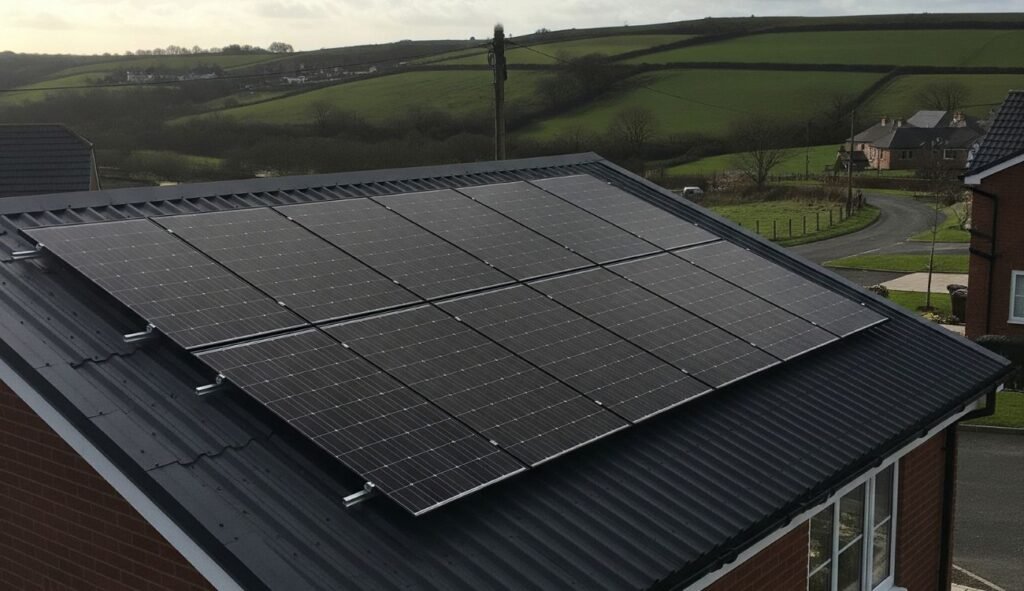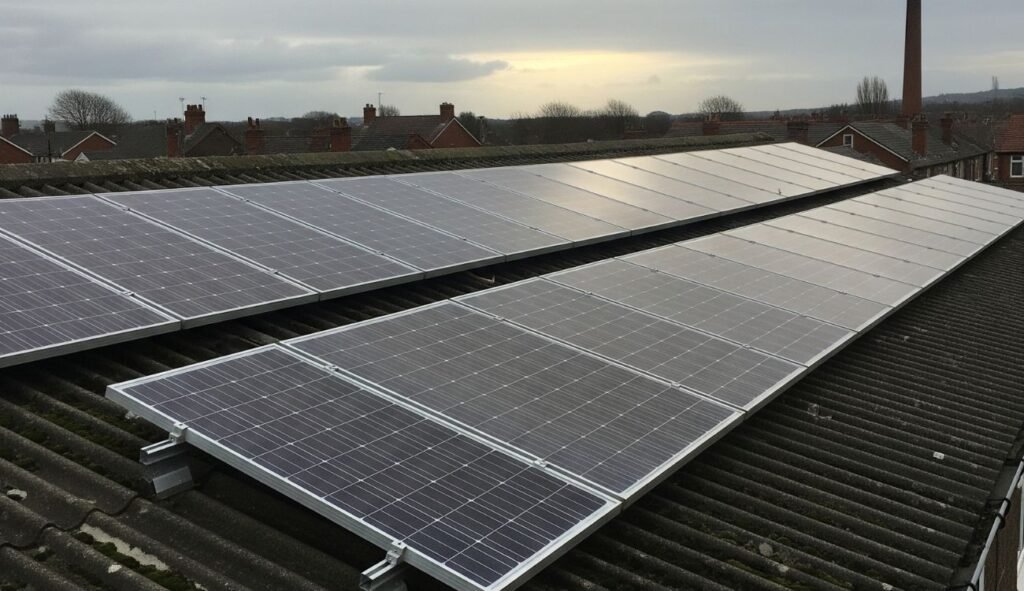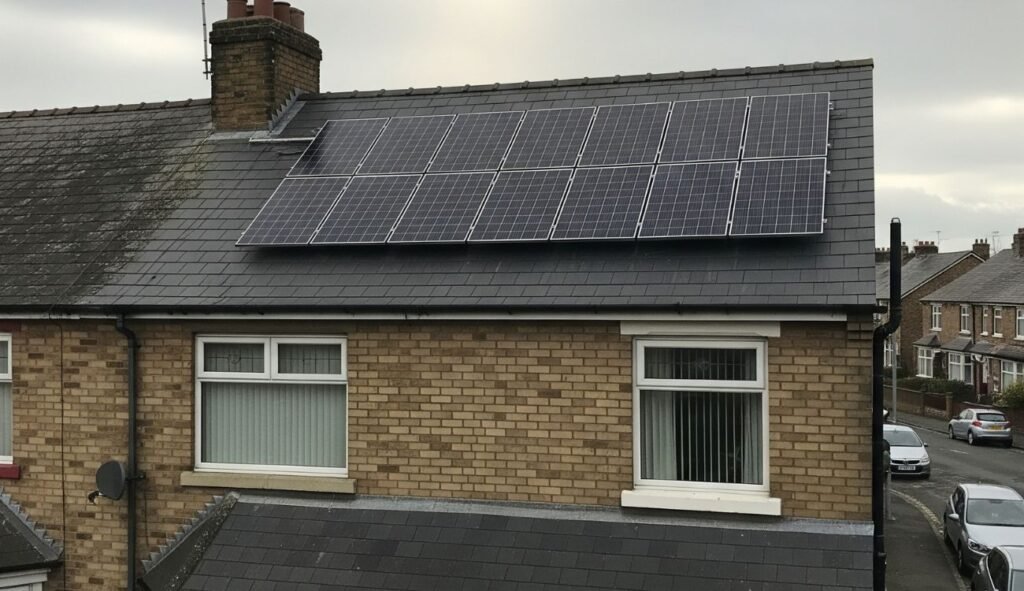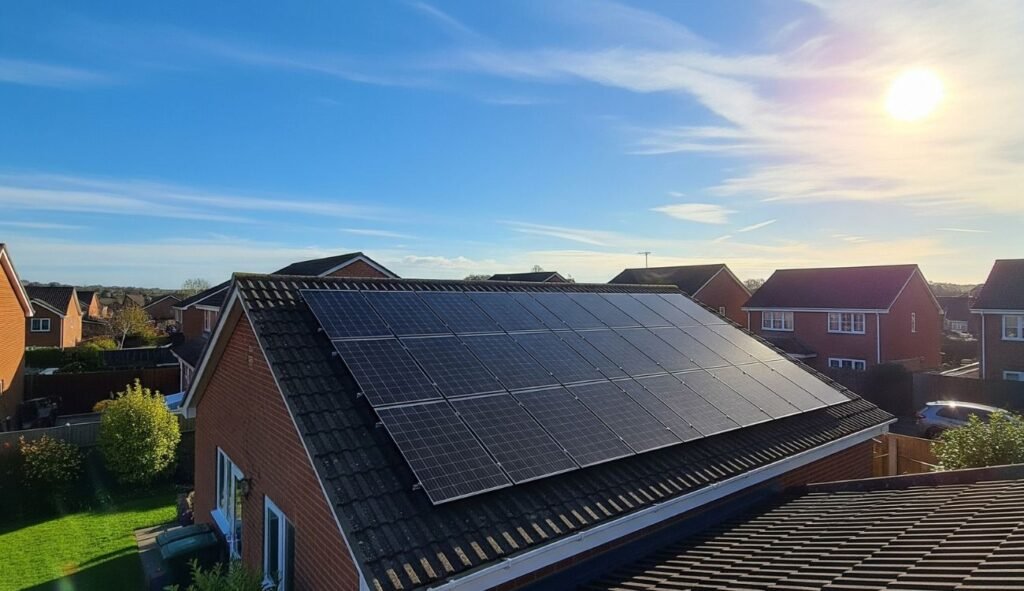Installing solar panels is one of the most effective ways to reduce energy bills, cut carbon emissions, and future-proof your property. But if your building has a rubber (EPDM) roof, you may be wondering if it’s a suitable surface for solar panel installation.
The good news? Yes, you can put solar panels on a rubber roof, but there are key considerations to ensure a safe, efficient, and long-lasting setup.
Can You Install Solar Panels on a Rubber Roof?
Yes, you can install solar panels on rubber roofs. Rubber roofs are commonly used on flat or low-pitched buildings, particularly in commercial settings and modern residential designs.
EPDM (Ethylene Propylene Diene Monomer) roofing is durable, weather-resistant, and can last for decades.
That being said, it’s vital that the right mounting system is used. Non-penetrating mounting systems, typically ballasted, are ideal, as they avoid drilling into the rubber membrane, which could compromise its waterproofing integrity.
Installers will assess the roof load capacity and angle to determine the best placement. In some cases, mounting systems may use adhesives approved for EPDM roofs.
If you’re in Tyne and Wear, Newcastle, or the wider North East, you can get expert advice and installation from Future Heat.
Our MCS certified professionals understand both solar technology and flat roofing systems to ensure your investment is protected from day one. Request your free solar panel installation quote today.
What Mounting Options Work Best on Rubber Roofs?
Ballasted systems are the go-to solution for solar on rubber roofs. They use weight to hold the solar panels in place, reducing the need to penetrate the roof membrane. These systems are especially common in commercial and flat roof installations.
For pitched rubber roofs, traditional rail-based systems with minimal roof penetrations can be used. Your installer will carry out a detailed structural assessment to ensure roof load compliance and long-term safety.
Are adhesive mounts viable?
In certain cases, solar mounts can be glued using EPDM-compatible adhesives. This method is more niche and often used where ballasting isn’t practical or aesthetic impact is a concern. It’s vital that the adhesive is compatible with EPDM to avoid roof damage.
How Efficient Are Solar Panels on Rubber Roofs?
Solar panels on rubber roofs can be just as efficient as on other roofing materials, provided they’re angled properly. Flat roofs often require angled mounting frames to optimise tilt toward the sun, typically between 30 and 40 degrees in the UK.
Wind resistance, shading, and panel orientation all play a role.
Modern systems include microinverters and optimisers to ensure maximum energy capture, even if some panels are partially shaded.
Do You Need Planning Permission for Solar Panels on Rubber Roofs?
In most cases, you do not need planning permission to install solar panels on a rubber roof at a residential property in England. Under the General Permitted Development Order (GPDO), solar panels are allowed without planning consent, provided:
- The installation does not protrude more than 200mm from the roof surface.
- Panels are not installed on a listed building or within a conservation area without additional checks.
- The system is not facing a highway on a pitched roof.
What about commercial properties?
For commercial buildings, planning rules can be slightly more complex. You may still fall under permitted development rights, but structural assessments and additional paperwork are often required, especially for listed buildings or conservation areas.
Working with an experienced solar installer like Future Heat, who understands the local planning and building regulations, is crucial for a smooth and compliant installation process.
Will Solar Panels Damage the Rubber Roof Over Time?
One of the top concerns from homeowners and landlords is whether solar panels will degrade their EPDM rubber roofs.
When professionally installed using non-invasive methods, solar panels can actually extend the lifespan of the roof by shielding it from UV exposure and harsh weather.
However, poor installation or using incompatible adhesives or mounts can lead to water ingress, membrane tearing, or thermal bridging.
That’s why it’s essential to choose a reputable installer. If you’re unsure how to choose a solar panel installer, we’ve got an entire guide dedicated to helping you make the right choice.
What Should You Consider Before Installation?
Whether you’re wondering how many solar panels you can fit on your roof or the best orientation for your setup, horizontal vs vertical solar panel installation can affect shading, energy output, and even roof stress. It’s essential to evaluate available space and sunlight exposure.
Prepare for seasonal variations
UK weather can be unpredictable, especially during the darker months. Many customers ask: do solar panels work in winter? Yes, they do, but output is lower due to shorter daylight hours.
That’s why battery storage is worth considering. On top of that, it’s crucial to choose the right size solar battery to meet your energy needs.
DIY or hiring trained professionals?
While some homeowners explore DIY options, most quickly discover that navigating mounting systems, electrical compliance, and roof warranties is no easy task.
You can learn more about whether you can install solar panels yourself, but for rubber roofs especially, hiring a professional is almost always the safer and more efficient route.
Do you have a flat rubber roof?
Flat rubber roofs are perfectly suited for solar, provided you’re using the right system. For more detail, check out our dedicated guide on installing solar panels on flat roofs.
Are Solar Panels Worth the Investment?
Absolutely. Solar panels don’t just help cut energy bills, they increase property value, reduce carbon footprint, and offer long-term returns. As solar power gains traction across the UK, we’re seeing a sharp rise in interest from both homeowners and business owners.
We’re often asked all sorts of practical questions like how many solar panels are needed to power a refrigerator, how many are required to heat a swimming pool, or even how many solar panels you need to run a hot tub. These are great indicators that more people are beginning to see solar as not just a cost-saving measure, but a way to fully power their lifestyle.
There’s never been a better time to explore the potential of solar energy for your property, whether you’re thinking about high-consumption appliances or entire system installations.
Frequently Asked Questions (FAQs)
Not if installed correctly. Most rubber roofing warranties remain valid as long as penetrations are avoided or sealed properly, and the installer uses approved mounting systems.
Not usually. Ballasted systems are designed to distribute weight safely, but a structural survey is always recommended, particularly for older buildings or large commercial setups.
Solar panels typically last 25–30 years, and EPDM roofs can last just as long with proper care. When combined, both can offer excellent longevity if installation is done professionally.
Yes. Through schemes like the Smart Export Guarantee (SEG), you can sell excess energy back to the grid.
Modern systems are rigorously tested for fire safety. Ballasted systems reduce penetrations, lowering risk. Be sure to use MCS-certified installers for compliant and safe installations.
Our Verdict
Installing solar panels on a rubber roof is not only feasible, it’s a smart move for forward-thinking property owners. With the right mounting system, no compromise to waterproofing, and the benefit of shading your roof, it’s a win-win. Just remember: every roof is different.
Myles Robinson is a seasoned expert in the boiler and home improvement industry, with over a decade of experience. He is deeply committed to environmental sustainability, actively promoting energy-efficient heating solutions to help households reduce their carbon footprint. By combining industry expertise with a dedication to environmental responsibility, Myles continues to lead efforts in transforming home heating practices towards a more sustainable future.











